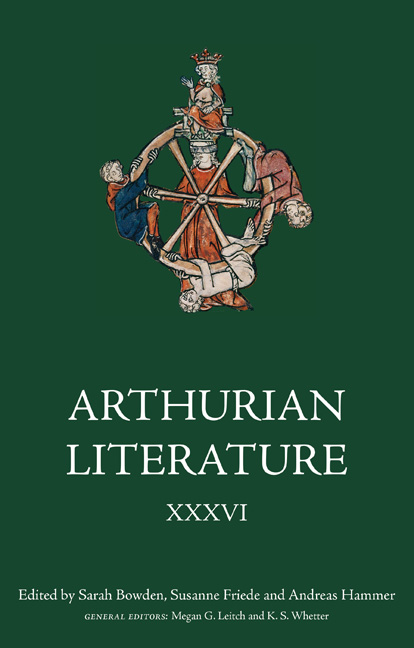Book contents
- Frontmatter
- Contents
- General Editors’ Preface
- List of Contributors
- Introduction: Sacred Space and Place in Arthurian Romance
- 1 The Church and the Otherworld: Sacred Spaces in the Matière de Bretagne and Medieval Ireland
- 2 Sacred Spaces: the Syntagmatic and Paradigmatic Construction of Narrated Space in Chrétien’s Conte du Graal
- 3 Perceiving the Way: Sacred Spaces and Imaginary Pilgrimage in the Vulgate Cycle Queste del Saint Graal and Thomas Malory’s ‘Tale of the Sankgreal’
- 4 Affirming Absence and Embracing Nothing: on the Paradoxical Place of Heterosexual Sex in Medieval French Verse Romance
- 5 Spaces of Remorse: Penitential Allusions in Iwein
- 6 The Spatial Narratives of Salvation and Damnation in Wigalois and the Prose Lancelot
- 7 ‘Fantoum and Fayryȝe’: Visions of the End of Arthurian Britain
- 8 The Tomb of the Kings: Imperial Space in Arthur’s Camelot
- Contents of Previous Volumes: Details of Earlier Titles are Available from the Publishers
7 - ‘Fantoum and Fayryȝe’: Visions of the End of Arthurian Britain
Published online by Cambridge University Press: 17 April 2021
- Frontmatter
- Contents
- General Editors’ Preface
- List of Contributors
- Introduction: Sacred Space and Place in Arthurian Romance
- 1 The Church and the Otherworld: Sacred Spaces in the Matière de Bretagne and Medieval Ireland
- 2 Sacred Spaces: the Syntagmatic and Paradigmatic Construction of Narrated Space in Chrétien’s Conte du Graal
- 3 Perceiving the Way: Sacred Spaces and Imaginary Pilgrimage in the Vulgate Cycle Queste del Saint Graal and Thomas Malory’s ‘Tale of the Sankgreal’
- 4 Affirming Absence and Embracing Nothing: on the Paradoxical Place of Heterosexual Sex in Medieval French Verse Romance
- 5 Spaces of Remorse: Penitential Allusions in Iwein
- 6 The Spatial Narratives of Salvation and Damnation in Wigalois and the Prose Lancelot
- 7 ‘Fantoum and Fayryȝe’: Visions of the End of Arthurian Britain
- 8 The Tomb of the Kings: Imperial Space in Arthur’s Camelot
- Contents of Previous Volumes: Details of Earlier Titles are Available from the Publishers
Summary
This article explores the role of the phantom in relation to legendary historical constructions of place. It takes as its focus Sir Gawain and the Green Knight (hereafter SGGK) and the first component romance of the bipartite Awntyrs off Arthure at the Terne Wathelyn (hereafter Awntyrs A). Unlike the other English Gawain romances, which typically trace the extension of Arthur's insular kingdom to the north and the west through the deeds of his knight Gawain, these are concerned not with the growth of Arthurian power but its decline. In their imaginings of insular imperium and its limits, both romances draw on a dominant medieval discourse explicitly concerned with place: political prophecy. A long tradition informed by Geoffrey of Monmouth's Historia regum Britanniae (c. 1138), and its prophetic seventh book, the Prophetiae Merlini, political prophecy in England is for the most part concerned with the movements of insular political power rather than religious revelation. It is, however, ascribed to a number of prophetic authorities alongside Merlin, which include among their number saints and even the Virgin Mary. The phantoms with which this article is concerned function as another distinct category of prophetic authority, on some occasions held to be synonymous with the fairy, and on others aligned with souls returned from purgatory. This material presents a salient reminder of the porous division between the sacred and the secular in Middle English romance. I suggest that both romances make use of longstanding purgatorial systems of representation, which provide a model for the interventions of phantoms in imaginings of the movements, and the limits, of earthly power.
Twelfth-and Thirteenth-Century Analogues
The political situation of the phantom is not unique to medieval Arthuriana. It is a staple of classical epic, which finds a precedent familiar to medieval authors, both sacred and secular, in Book VI of the Aeneid, where the shade of Anchises prophesies to Aeneas a succession of Roman emperors, and the attendant fortunes of Rome. The motif recurs throughout the Middle Ages, including the Vision of Charles the Fat (c. 888), an apocalyptic prophetic endorsement of the accession of the future Louis III, delivered by his uncle and grandfather from purgatory.
- Type
- Chapter
- Information
- Arthurian Literature XXXVISacred Space and Place in Arthurian Romance, pp. 149 - 174Publisher: Boydell & BrewerPrint publication year: 2021



